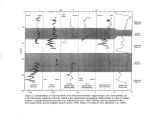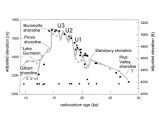| OCR Text |
Show early Pleistocene, although west- central Utah was apparently wetter than today until at least the Brunhes/ Maruyama boundary. Middle and Late Pleistocene: A major change in the behavior of the climatic system of the eastern Great Basin occurred during the time interval encompassing the Brunhes/ Maruyama paleomagnetic reversal (- 780 ka; Cande and Kent, 1995) and the deposition of the Bishop Ash ( 759 ka, Sarna- Wqjcicki and Pringle, 1992). The timing, persistence, and amplitude of lacustrine events in the Bonneville Basin was very different in the periods before and after this interval. In the southern Bonneville Basin, persistent wide- spread shallow lake and marsh complexes left a nearly continuous record of sedimentation from prior to 3 Ma until the earliest Brunhes Chron ( Oviatt, 1991; Thompson et al., 1995). This sedimentation ceased soon after the deposition of the Bishop Ash, and the only wide- spread lacustrine deposits of Brunhes age in the southern Bonneville Basin are related to large relatively short- lived pluvial lakes ( Lake Bonneville and its precursors). It is possible that this regional change is related to the opening of the connection between the drainages of the southern Sevier subbasin of the Bonneville Basin with the more northerly Great Salt Lake subbasin. However, pollen data from Great Salt Lake ( Davis and Moutoux, 1996) also indicate that a major change in behavior occurred at approximately 750 ka and there is evidence in a shift in global climate at or near this time. Farther north in the Bonneville Basin, an east- west transect of cores south of Great Salt Lake ( Eardley et al., 1973) contains evidence of fresh- water lakes that periodically flooded the Great Salt Lake and Great Salt Desert subbasins ( Oviatt and Thompson, 1996). We have identified only four such fresh- water episodes during the Brunhes. The lowermost of these underlies the Lava Creek tephra ( 620 ka) and the uppermost represents Lake Bonneville (~ 28 to 12 ka), and we hypothesize that fresh- water lakes may only occur in the Great Salt Lake basin during the largest of the continental glaciations, which are reflected as large excursions in the marine oxygen isotope record ( Imbrie et al., 1984; as indicated by the isotope " stages" in the following text). The lake that occurred prior to the deposition of the Lava Creek B tephra would have occurred during Stage 16 and Lake Bonneville broadly corresponds with Stage 2. We estimate that the remaining two lake episodes occurred during isotope stages 12 and 6, which are the remaining two large excursions in the marine oxygen isotope record for the Brunhes Chron. The last 30,000 years: In contrast to the sketchy data available for the earlier record, a wealth of paleoenvironmental and chronological data provide a detailed history of the last 30,000 years of paleoclimatic and paleohydrologic changes. During this period, continental glaciers in the Northern Hemisphere advanced, reached their maximum, and then retreated. This transition from pre- full glacial to full- glacial to post- glacial times was paralleled by similar general trend in effective moisture in the eastern Great Basin ( Benson et al., 1990; Oviatt et al., 1992; Thompson et al., 1990), although the maximum depth of Lake Bonneville may have lagged the full- glacial by several thousand years. Indeed the ties between lake- level variations and Ice Sheet fluctuations may have been very close - recent studies suggest that Heinrich events in the North Atlantic, tied to changes in the Laurentide Ice Sheet, may have caused millennial- scale variations in Great Basin pluvial lakes ( Benson et al., 1996; Oviatt, 1997). The desiccation of Lake Bonneville was followed by a short- lived fresh- water lake phase during the late glacial, after which Great Salt Lake has apparently remained a saline water body which has experienced only small- scale variations ( compared to earlier) in water depth. Lacustrine changes in the non- glacial world of the Holocene have been caused by variations in insolation, as they affected the radiation balance and atmospheric circulation ( COHMAP 1988, Thompson et al., 1993). |

































































































































































